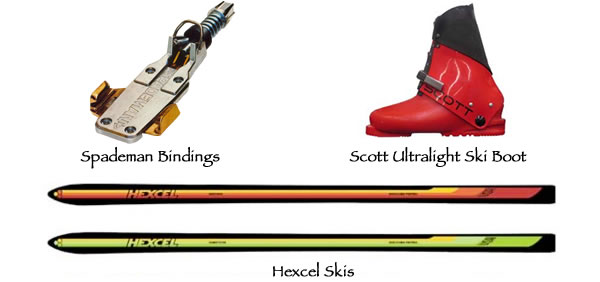Lighter Isn’t Always Better
Infamous “Light” Gear
Embedded in every pitch or patch of prose about next year’s skis is a word or two about how the new model is lighter than the ponderous slab it’s replacing. “Lighter is Better” (LIB) has become ski market dogma; the words might as well be written in neon over the entrance to the annual trade show.
Leading the LIB charge is carbon, number six on the periodic table and number one on every ski maker’s list of LIB materials. Carbon Tank Mesh. Full Carbon Jacket. Carbon Alloy Matrix. CFX Superfiber. Graphene. Carbon Flipcore. These are but a few of the seemingly infinite incarnations of carbon in 2017 alpine ski product lines.
Of course carbon has been part of the ski designer’s palette since before shaped skis transformed the sport. Carbon’s current prevalence as a lightweight element is at least partly driven by the surging sub-culture of side-country and backcountry skiing, domains where lightening the load have always been part of the product story.
Another segment of the ski market where weight loss has long been a central sales argument is women’s skis, where substituting lighter core materials – e.g., foam, balsa, Paulownia, bamboo – is considered de rigeur. Yet it wasn’t so long ago that one of the most popular brands of women’s skis was Volant, which weighed only slightly less than a Fiat. The first generation of K2’s Luv series won over a small army of women who loved their Luvs as long as they had some Galahad to carry them.
The recorded history of great ski gear that touted lighter weight as its paramount virtue is a slim volume. Once upon a time Rossi tried to pass off an ultralight foam-injected ski as a performance product; the ROI on a ski it took less than a minute per pair to make would have been spectacular if only the 4SV hadn’t been garishly bad.
The first generation of honeycomb-core Hexcels lost all interest in conventional notions of snow contact at about 35mph. Scott’s Superlight boots – once considered standard issue for serious mogul skiers – remained in one piece as long as they weren’t used for skiing. Toe-less Spademan bindings didn’t do diddley to interrupt shock delivered to the ski’s forebody, which may explain why so many bump skiers opted not to use the front of their skis.
One needn’t look to the misty past to find an era when skiers not only didn’t dither over an extra gram here and there, but preferred their skis with added avoirdupois. The time is now and the genre is race skis.
Race skis are like sumo wrestlers; a few extra lbs. only make them better at their job. Now that race skis are shorter than ever, they need all the reinforcement they can get. Take heed of what Bart Pierce, the hands-on owner of Pierce Skate & Ski, where they devote more time and energy to serving the race community than any other shop in America, has to say about the perils of applying LIB-think to racing:
“I’m not expert when it comes to materials, but over the past 35+ years of servicing the race community, I have become an expert when it comes to warranty claims, especially for slalom skis. At a certain point they ALL break, some more than others… By using lighter weight materials [in race skis] there would be potential for less efficient energy transfer, less stability at higher speeds and even greater durability issues.”
Pierce goes on to admit that for his personal use lighter-is-better gear works just fine.
At realskiers, we agree that the LIB philosophy definitely has its proper place, and that more mass, by itself, is no more a virtue than lightness. An enormous powder ski like Nordica’s late and unlamented Jah Love (140mm underfoot and weighing more than a baby hippo) is an epoophany – or what happens when a bad idea hits the fan.
Trimming the fat off the beefiest powder models is perhaps the best application of LIB ideology. The Blizzard Bodacious, for example, became decidedly more manageable when it jettisoned twin Titanal layers and added a dash of – what else? – carbon.
Just because lighter isn’t always better doesn’t mean there aren’t times when it is. But lighter weight, in and of itself, isn’t necessarily beneficial.

